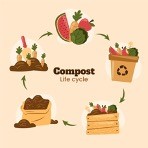Sustainability Begins at the Compost Pile
- 2023-01-05
- By mkirk
- Posted in Horticulture, The Garden Buzz
By Judy Kunz, Colorado Master Gardener

There’s no doubt about it. Our native soils are frequently less than ideal when it comes to gardening. That black, crumbly soil that falls apart when squeezed in our hands may occur in other parts of the country, but, for the most part, it just doesn’t naturally exist here. While our Front Range soils usually contain many of the nutrients needed for healthy plants, heavy clay with small soil particles, meager pore space and low organic content can be a gooey substance that leaves little oxygen for plant roots to thrive.
Illustration: freepik.com
Fortunately, there is an easy, no-cost way to improve garden soils that is also good for the environment. Composting every-day kitchen scraps and yard waste costs very little, takes minimal commitment and helps cut down on the release of greenhouse gases. The reward is black organic matter that breaks up clay, promotes healthy plant growth, helps retain moisture and nutrients and reduces the need for fertilizers.
According to the FDA, approximately 30-40% of food in the U.S. is discarded, eventually ending up in landfills. In an age when record amounts of waste are going to landfills, we have the opportunity to rethink how we are disposing of it and what kind of footprint we are leaving for future generations. Composting is one answer to the ever-increasing ecological problem of food and yard waste.
Compost ingredients are readily available around most households. A good compost mix contains two parts nitrogen (green) to one part carbon (brown). When properly aged and mixed with garden soil, it creates a hospitable environment for the growth and retention of beneficial organisms. Or, used as a top dressing, compost keeps in moisture, discourages weed growth, and pulls the look of the garden bed together. The end result is both a healthy and attractive garden.
For convenience, compost structures can be located near the garden where you will use the compost. They’re easy to build or relatively inexpensive to purchase. While compost structures aren’t necessary, they can look more attractive than free standing piles and make it easier to control animal access.
Photo: lawnstarter.com

Make composting a resolution for 2023. Collectively we can make a difference in our environment by helping to reduce the solid waste stream and, at the same time, enhance the function and beauty of our gardens.
Get a start on composting with these common materials:

2 Responses on “Sustainability Begins at the Compost Pile”
Leave a Reply Cancel reply
Horticulture Resources
- Garden Buzz Archives
- CSU Extension Resources
- Colorado Master Gardener Program
- Foothills to Plains Native Plant Master Program
- Native Bee Watch Community Science Program
- The Co-Hort Blog
- PlantTalk Colorado
- Soil Testing
- Plant Select
- Emerald Ash Borer
- Japanese Beetle
- Colorado State Forest Service
- Ask an Expert



How do I avoid problems with mice and rats that might be attracted to the compost pile?
Hi Sheila:
I sent your question to Judy Kunz who is the author of the article.
Thanks for reading!
Martha Kirk